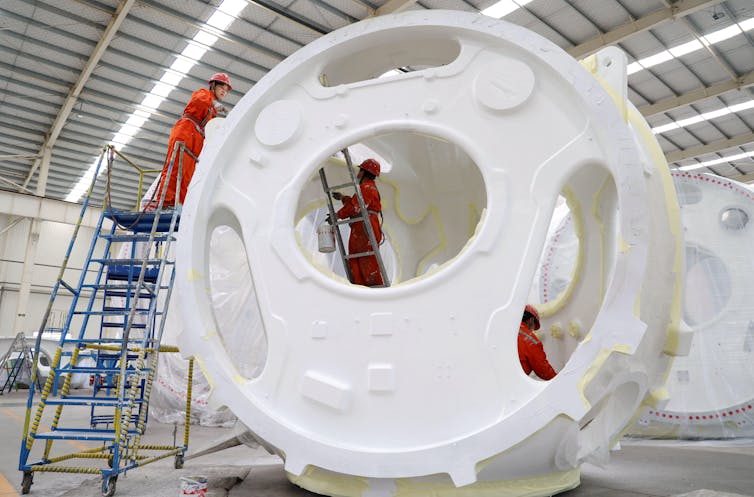Key Takeaway:
China’s new export regime is reportedly in response to western restrictions on equipment essential for semiconductor devices, such as the US CHIPS and Science Act of 2022. This could affect Beijing’s capacity for high-performance computing in areas like defense. Both germanium and gallium are crucial to technological advancement, with germanium being particularly useful in space technologies and gallium being used in semiconductors. China controls 60% of all germanium supplies, derived from zinc production and coal. The US is one of the alternative suppliers, but is still over 50% reliant on imported germanium. The war between Russia and Ukraine has affected supply to the west, and Russia plans to increase germanium production for its domestic market. The long-term effects of these controls are difficult to predict due to various factors. China controls materials vital for the net zero transition, and the move is a significant escalation in the tech war between China and the west.
From August, China is to restrict exports of gallium and germanium, two critical elements for making semiconductor chips. With China dominating the supply of both elements, exporters will now need special licences to get them out of the country. The move has the potential to harm a range of western tech manufacturers that use these elements to make their products.
The move is reportedly in response to western restrictions of equipment vital for making semiconductor devices (and was forewarned in an previous article in The Conversation). Above all, the US CHIPS and Science Act of 2022 curtailed exports of high-end microchips and technology to China, potentially affecting Beijing’s capacity for high-performance computing in areas such as defence. Other nations such as Japan and the Netherlands have also imposed restrictions.
So how important are the new Chinese restrictions and what are the implications likely to be?
The importance of gallium and germanium
Silicon is the most widely used material in semiconductors, and is very abundant. But germanium and gallium have specific properties that are hard to replicate and lend themselves to certain niche applications. These get incorporated into countless devices such as smartphones, laptops, solar panels and medical equipment, as well as defence applications.
Both elements are also crucial to technological advancement over the next few years. Germanium is particularly useful in space technologies such as solar cells because it is more resistantto cosmic radiation than silicon. With the physical limits of silicon being approached in some technologies, increased use of germanium is mooted as a way of overcoming these limits. It is already used in small quantities in some semiconductors to improve things like electron flow and thermal conductivity.
As for gallium, 95% of it is used in a material called gallium arsenide, which is used in semiconductors with higher performance and lower power-consumption applications than silicon. These are used in things like blue and violet LEDs and microwave devices.
Meanwhile, gallium nitride is used in semiconductors in components for things like electric vehicles, sensors, high-end radio communications, LEDs and Blu-Ray players. Its use is expected to grow significantly.
Both gallium and germanium are on the European Union and US lists of critical elements. The UK considers gallium to be critical to its manufacturing interests, though sees germanium as less important.
Where they come from
China controls about 60% of all germanium supplies. The element is derived in two main ways, as a by-product of zinc production and from coal. These respectively account for about 75% and 25% of the total supply. China dominates germanium that comes from zinc production. The US is one of the alternative suppliers, with deposits in Alaska and Tennessee and additional refining capacity in Canada. But as it stands, the US is still over 50% reliant on imported germanium.
Germanium from coal has several drawbacks. Two of the main producers are Russia and Ukraine, and the war has affectedsupplies to the west from both countries. In the years 2017-20, Russia was supplying 9% of the US germanium requirement, for instance, but this is now likely to have stopped. In response to the Chinese restrictions, Russia plans to increase germanium production for its domestic market. This may at least alleviate global demand, even if it won’t help the west directly.
Germanium from coal is also at the mercy of the power industry, since certain coals rich in the element are burned as an energy source. In addition, germanium from coal will become more difficult as much of the world seeks to phase out coal power, which again could tighten supplies.

With gallium, China accounts for around 80% of the world supply, deriving it mainly from aluminium production. There’s actually no shortage of gallium, but even before the new controls, the supply was restricted by a lack of production capacity.
Gallium is also obtained by recycling semiconductor wafers, which are thin slices of semiconductor used in electronic circuits. But once the circuits are integrated into products, the quantities of gallium in each one are so small that it becomes challenging to recycle. A Nature Communications paper in 2022 noted that gallium is “almost never functionally recycled” once it reaches final products.
The implications
The full impact of China’s new export regime depend on a number of factors, including the severity of the controls in practice, and the response of western governments and companies. As it stands, the controls look likely to lead to higher prices for gallium and germanium, as well as longer delivery times.
This could make it more expensive and difficult for western companies to produce electronic devices, which could in turn lead to higher prices for consumers. It could also make it more difficult for western companies to compete with Chinese companies. In an echo of how the global microchip shortage during the COVID pandemic considerably affected tech manufacturing, this points to a significant impact on the global economy.
The long-term effects of the controls are difficult to predict because so many factors are involved. Stockpiles of the elements should help to some extent: the US has said it holds inventory of germanium, though not gallium.
Western manufacturers may be forced to diversify their supply chains by obtaining components containing the elements from countries to which China is willing to export. This could lead to increased costs and complexity.
Another avenue is to increase production from alternative sources. In the past, germanium has been derived from minerals mined in Germany, Latin America and Africa, so these options may come back on the table. There is also the potential to invest in researching devices that are less reliant on these critical materials, but that would take time to bear fruit.

Clearly, the move is a significant escalation in the tech war between China and the west. The concern is that it could go further: China dominates the supply of a whole range of vital materials known as rare earth metals, as well as other materials which are required for the clean energy transition. Even before the escalation in hostilities over the past couple of years, China had used its dominance over certain materials as leverage in trade disputes.
So this latest development is concerning to say the least. At a time when the international challenges faced by humanity are greater than ever, the emergence of a new resource nationalism is the last thing anyone needed.






























